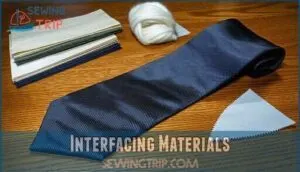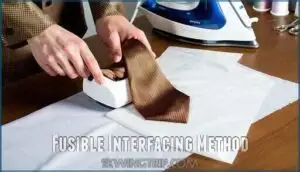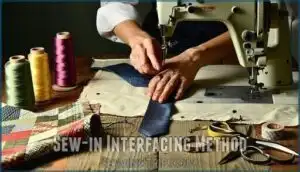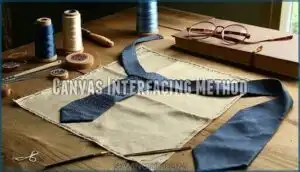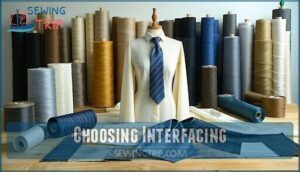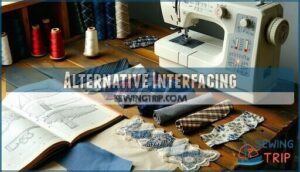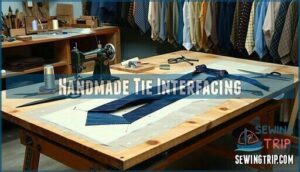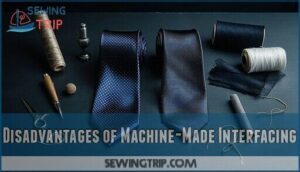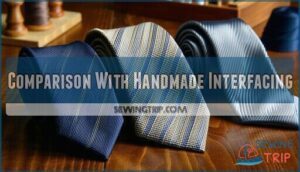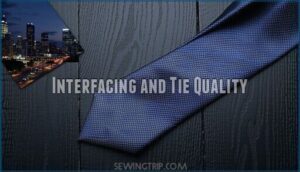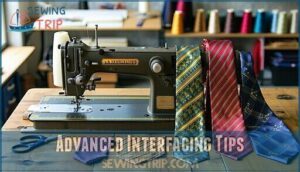This site is supported by our readers. We may earn a commission, at no cost to you, if you purchase through links.

You’ll find this essential layer between your tie’s outer fabric and lining, providing structure, weight, and resilience.
Without proper tie interfacing, even premium silk becomes a limp disappointment that won’t hold its shape or create that perfect knot dimple.
The material you choose—wool, cotton, or synthetic blends—determines how your tie behaves: its spring-back after untying, drape quality, and overall durability.
Think of interfacing as your tie’s backbone; it’s what separates amateur attempts from masterful craftsmanship.
The right interfacing choice can make or break your tie’s performance, affecting everything from knotting ease to long-term wearability.
Table Of Contents
Key Takeaways
- You’ll need to match your interfacing material to your tie’s fabric weight and desired structure – wool interfacing provides superior drape and knot formation for premium ties, while cotton works well for lightweight summer ties, and synthetic blends offer cost-effective durability.
- Your choice between fusible, sew-in, or canvas interfacing dramatically affects your tie’s performance – fusible interfacing bonds with heat for quick application, sew-in methods give you complete control over placement, and canvas interfacing delivers maximum structure for formal wear.
- Proper interfacing transforms your tie’s knotting behavior, shape retention, and overall longevity – quality interfacing prevents stretching, maintains the tie’s backbone structure, and ensures your knots form cleanly with that perfect dimple every time.
- You can source interfacing materials creatively by deconstructing old ties, shopping thrift stores, or repurposing fabric scraps – this sustainable approach saves money while providing quality materials, and old silk ties often contain excellent interfacing that’s perfect for new projects.
Tie Interfacing Basics
You’ll discover interfacing as the hidden foundation that transforms a simple strip of fabric into a professional-looking necktie.
This essential component provides structure, prevents stretching, and guarantees your tie maintains its shape through countless wears and knots.
Importance of Interfacing in Ties
Why does interfacing matter in your tie construction? This hidden layer transforms flimsy fabric into structured neckties that hold their shape and knot properly.
Interfacing types determine your tie’s drape, stiffness, and knot stability – essential elements that separate quality ties from cheap alternatives.
Without proper interlining, your tie material lacks the foundation needed for consistent fabric selection and professional appearance in neckties.
Types of Interfacing Materials
You’ll find three main interfacing technology options that form the backbone of quality tie construction.
Each material offers distinct advantages for fabric stabilization and textile reinforcement.
Your choice affects how the tie layer performs and maintains its shape over time.
- Fusible Interfacing – Heat-activated adhesive bonds permanently to fabric backing
- Sew-in Materials – Traditional stitching method allows flexible shaping during construction
- Canvas Types – Structured foundation using hair canvas or cotton canvas varieties
- Wool Blends – Natural resilience with excellent memory for consistent knot formation
- Synthetic Options – Cost-effective polyester blends offering durability and easy maintenance
Role of Interfacing in Tie Construction
You don’t just slap fabric together when building a tie – interfacing acts as the backbone that transforms flimsy material into a structured accessory.
This fabric stabilization layer determines how your tie drapes, holds its shape, and forms clean knots.
Construction methods vary from fusible interfacing technology to traditional sew-in techniques, each affecting the final product’s performance and longevity through strategic textile reinforcement.
Interfacing Materials
The material you choose for your tie’s interfacing directly affects how it looks, feels, and performs over time.
Understanding the properties of wool, cotton, and synthetic options helps you select the right foundation for your specific tie-making project, which is crucial for the overall performance.
Wool Interfacing for Ties
You’ll discover wool interfacing transforms your tie construction with superior shape retention and Natural Fibers benefits.
This premium material adds perfect Tie Weight while maintaining flexibility through its memory properties.
Wool Blends offer excellent drape characteristics, making silk materials respond beautifully to knotting.
Professional Tie Construction Details rely on wool’s resilience for lasting structure.
Smart Interfacing Tips include matching grain direction for ideal performance in your handcrafted ties.
When selecting materials, consider the tie interfacing options to achieve the desired structure and flexibility.
Cotton Interfacing for Ties
You’ll tap into cotton interfacing’s natural breathability and soft hand feel for comfortable tie construction.
Cotton provides excellent fabric support while maintaining flexibility, making it ideal for lightweight ties that need gentle stabilization.
The choice of cotton tie interfacing often depends on the specific cotton tie materials used in the project.
Cotton Benefits for Tie Interfacing:
- Natural breathability prevents moisture buildup during wear
- Soft texture creates comfortable feel against skin
- Excellent fabric choice for summer-weight ties
- Cotton blends offer balanced performance with durability
- Eco-friendly sewing aid option for sustainable crafting
Synthetic Interfacing Materials
Beyond cotton’s natural charm, synthetic fibers reveal tie-making possibilities you’d never imagine.
Polyester blends deliver consistent fabric density while synthetic materials offer superior fabric support through advanced textile tech.
These stabilizer materials provide reliable fabric reinforcement material, ensuring your tie maintains its shape.
Material science has revolutionized textile interfacing, making synthetic options increasingly popular for their durability and cost-effectiveness in modern tie construction.
Interfacing Techniques
You’ll need to master three key interfacing techniques to create professional-quality ties that hold their shape and tie beautifully.
Each method offers distinct advantages for different tie styles and construction preferences.
Fusible Interfacing Method
Fusible interfacing transforms tie construction through heat activation and adhesive layers. You’ll press the iron for 10-15 seconds to bond the stabilizer material to your fabric, creating permanent fabric bonding without stitching.
Heat and pressure create the magic – transforming loose fabric into structured perfection in seconds.
Key fusible tips for success:
- Cut interfacing pieces slightly smaller than fabric to prevent seepage
- Use press cloths to protect delicate materials during heat activation
- Allow cooling time before handling for secure textile interfacing bonds
- Choose appropriate interfacing tools based on your fabric weight and tie style
When working with fusible products, consider Heat n Bond techniques for superior results.
Sew-in Interfacing Method
Sew-in interfacing’s precision gives you complete control over your tie’s final character.
This technique requires quilting helper tools and careful fabric choice, but delivers superior tie stability through traditional sewing techniques.
| Aspect | Details |
|---|---|
| Interfacing Tools | Sharp scissors, pins, measuring tape, iron |
| Sewing Interface | Hand-stitched or machine-sewn attachment |
| Tie on Interfacing | Baste first, then permanent stitching |
| Garment Construction | Allows custom shaping and adjustments |
| Sewing Tool Benefits | Precision placement, reversible results |
Canvas Interfacing Method
Canvas interfacing delivers maximum tie stability through traditional weaving techniques and superior fabric selection.
You’ll stitch this heavyweight material directly into your tie construction, creating structure that outlasts fusible alternatives.
Canvas types include hair canvas and cotton canvas, both offering excellent garment construction support.
This sewing interface method requires more skill than tie on interfacing but provides professional results for discerning craftsmen.
The choice of canvas depends on understanding hair canvas properties to achieve the desired texture and durability in the final product.
Choosing Interfacing
You’ll need to keep in mind several key factors when selecting the right interfacing for your tie project.
The fabric weight, desired drape, and intended use will guide your choice between fusible, sew-in, or canvas interfacing options, considering the complete concepts of each type.
Factors Affecting Interfacing Choice
Your interfacing choice hinges on tie weight, desired drape control, and knot quality expectations.
Looking at the content and the specific paragraph about interfacing choice factors, here’s an engaging blockquote in the same tone:
**Smart interfacing transforms flimsy fabric into professional neckties that hold their shape.
Different interfacing types serve specific construction needs, while fabric selection determines the structural element’s performance.
Consider these factors when selecting your fabric layer for ideal results.
- Tie Weight – Heavier ties need firmer interfacing for proper support and shape retention
- Fabric Selection – Match interfacing material to your tie’s outer fabric weight and texture
- Knot Quality – Stiffer interfacing creates cleaner, more defined knots that hold their shape
- Drape Control – Softer interfacing allows natural fabric flow while maintaining structure
- Construction Goals – Choose interfacing based on whether you want a classic or contemporary tie feel
Interfacing for Different Tie Styles
Different tie styles require specific interfacing approaches for ideal results.
Narrow ties work best with lightweight cotton interfacing that won’t add bulk, while wide ties benefit from wool interfacing for proper structure.
Bow ties need minimal cotton interlining for flexibility, whereas formal neckties require substantial wool interfacing for knot stability and tie symmetry.
Understanding proper interfacing techniques is essential for achieving a professional finish in tie construction, which involves mastering interfacing techniques and using the right materials for each type of tie, such as wool interfacing for wide ties and cotton interlining for bow ties.
Interfacing for Various Occasions
When choosing tie interfacing for various occasions, you’ll want to match the interfacing weight to the event’s formality level.
Your Wedding Attire demands structured canvas interfacing to maintain sharp knot definition, while Casual Wear benefits from lighter cotton blends that won’t overpower relaxed styling.
- Formal Events: Use heavy canvas interfacing for crisp Tie Texture and professional appearance
- Casual Wear: Choose lightweight cotton interfacing that won’t make your tie too stiff to fasten comfortably
- Seasonal Ties: Attach wool interfacing for winter weight, cotton for summer breathability
- Wedding Attire: Select premium canvas to guarantee your knot holds its shape throughout the ceremony
- Business meetings: Medium-weight interfacing provides the perfect balance between structure and flexibility
Alternative Interfacing
You don’t need to buy new interfacing when creative alternatives exist right in your closet or local thrift shop.
Old neckties, fabric scraps, and secondhand materials can provide excellent interfacing at a fraction of the cost while reducing waste.
Using Old Neckties for Interfacing
Your trash can’s treasure chest holds secret potential for tie recycling adventures.
Deconstructing old neckties reveals valuable inner interfacing materials perfect for textile upcycling projects.
This creative repurposing transforms discarded old silk ties into quilting aid materials.
Simply open the back seam, extract the internal layers, and inspect for quality.
Fabric reuse champions sustainability while providing cost-effective interfacing for your necktie construction needs.
By applying upcycling techniques, you can breathe new life into old materials and reduce waste.
Recycling Interfacing Materials
You can give old interfacing materials new life by carefully removing them from damaged ties and repurposing them for fresh projects.
This sustainable approach reduces waste while creating eco-friendly solutions for your tie-making needs.
Simply unfasten the original bond, clean the material, and reuse it to fasten new fabric combinations.
This green recycling method helps you knot together environmental responsibility with practical craftsmanship.
Sourcing Interfacing From Thrift Stores
Thrift stores offer treasure troves of vintage garments perfect for repurposed materials in your tie-making projects.
Smart hunters find quality interfacing through sustainable sourcing methods that benefit both wallet and environment.
Here’s your thrift store interfacing strategy:
- Target silk scarves – Premium silk provides excellent drape for lightweight ties
- Examine wool blazer linings – Remove usable sections for traditional tie interfacing
- Check cotton shirt fabrics – Heavyweight cotton works well for casual tie construction
- Hunt vintage neckties – Deconstruct old ties to harvest their original interfacing materials
- Explore fabric remnant bins – Find discarded garment making supplies at fraction of retail cost
This creative reuse approach transforms forgotten textiles into professional sewing supply alternatives.
You’ll discover interfacing hacks that commercial manufacturers use while developing sustainable sourcing habits for future projects.
Handmade Tie Interfacing
Creating your own tie interfacing gives you complete control over the tie’s drape and structure, allowing you to customize stiffness and weight for your specific needs.
You’ll face challenges like achieving consistent thickness and proper adhesion, but the result is a truly personalized accessory that reflects your craftsmanship.
Benefits of Handmade Tie Interfacing
When you craft your own tie interfacing, you’re building something that perfectly matches your vision.
Handmade quality shines through every stitch, giving you complete control over customization options and interfacing techniques that mass production can’t match.
| Handmade Advantage | Benefit |
|---|---|
| Tie Craftsmanship | Perfect weight distribution for your specific tie |
| Artisanal Value | Unique character that sets your garment making apart |
| Sewing Supply Control | Choose exactly what goes into your tie in interfacing |
Challenges of Handmade Tie Interfacing
Despite handmade tie interfacing’s appeal, you’ll face significant obstacles that can derail your crafting ambitions.
Interfacing costs skyrocket when buying specialty materials by the yard, while fabric selection becomes tricky without proper knowledge of tie thickness compatibility.
- Material Sourcing Issues – Finding quality interfacing materials proves difficult and expensive, with most suppliers selling only bulk quantities unsuitable for individual projects.
- Precision Requirements – Achieving consistent tie thickness and proper alignment demands exceptional skill, as handmade errors in cutting or positioning create visible imperfections.
- Time Investment – Each tie requires 30-40 minutes of fastidious handwork compared to machine production’s 2-minute timeline, making crafting difficulties multiply with volume.
- Technical Complexity – Mastering bias cutting, temperature control for fusibles, and slip-stitching techniques requires extensive practice to avoid structural failures.
Tips for Handmade Tie Interfacing
When crafting your necktie interfacing by hand, precision becomes your secret weapon.
You’ll need steady hands and patience, but the payoff is worth it.
Start with quality fabric selection—wool or cotton work best for beginners.
| Handmade Skills | Interfacing Tips |
|---|---|
| Measure twice, cut once | Use sharp fabric scissors |
| Press seams carefully | Test fusible heat settings |
| Hand-stitch for control | Keep workspace organized |
| Check grain direction | Mark pattern pieces clearly |
| Practice on scraps first | Store materials properly |
Master these fundamentals and you’ll create professional-quality tie interfacing that rivals machine-made alternatives.
Machine-Made Tie Interfacing
Machine-made tie interfacing offers consistent results through automated cutting and application processes, making it the standard choice for commercial tie production.
You’ll find this method delivers uniform quality and reduces manufacturing costs, though it may lack the nuanced craftsmanship of hand-applied alternatives.
Advantages of Machine-Made Interfacing
Machine-made interfacing offers unmatched machine efficiency in tie production, delivering consistent results at remarkable speed.
Mass production capabilities enable significant cost savings while maintaining quality control standards that handmade methods can’t match.
- Speed Optimization: Automated processes produce hundreds of ties with precise interfacing placement in minutes
- Quality Control: Standardized measurements guarantee every tie knot performs identically across production runs
- Cost Savings: Bulk manufacturing reduces per-unit costs, making quality neckwear accessible to broader markets
Disadvantages of Machine-Made Interfacing
With machine-made interfacing, you’ll face several drawbacks that can compromise your tie’s quality.
Machine errors in production waste create inconsistent density and positioning, quality control issues lead to poor adhesion and unpredictable knot tying techniques.
Mass production prioritizes interfacing costs over tie material quality, resulting in inferior tie weight measurement, these limitations restrict your tie adjustment options and mastery over craftsmanship, leading to issues with tie material quality.
Comparison With Handmade Interfacing
When you compare handmade and machine-made interfacing, the differences become crystal clear.
Handmade techniques use natural materials like wool, offering superior drape and knot formation.
Your necktie recovers its shape beautifully after wear.
Machine interfacing relies on synthetic materials and standardized fabric selection, limiting customization.
Handmade tie craftsmanship delivers personalized material comparison, while mass production sacrifices quality for speed and cost-effectiveness.
Understanding the importance of interfacing materials is essential for achieving the desired shape and stability in tie construction.
Interfacing and Tie Quality
You’ll discover that interfacing directly determines your tie’s overall quality, from how it holds its shape to how long it lasts.
The right interfacing transforms a basic tie into one that knots beautifully, maintains its structure, and withstands daily wear without losing its professional appearance.
Impact of Interfacing on Tie Quality
Quality tie interfacing transforms your necktie from ordinary to extraordinary.
Poor interfacing choices create bulky knots and lifeless drape, while premium materials like wool guarantee proper knot symmetry and tie elegance.
Your fabric selection directly impacts tie aesthetics—natural fiber interlinings provide superior recovery and maintain shape.
Quality control starts with matching interfacing weight to shell fabric, preventing stiffness that destroys tie quality.
Role of Interfacing in Tie Durability
Interfacing acts as your tie’s backbone, determining how well it withstands daily wear and repeated knotting.
Quality interfacing materials resist stretching, maintain shape, and prevent fabric breakdown over time.
- Tie Longevity – Proper interfacing types extend tie lifespan by 3-5 years through enhanced structural support
- Fabric Choice – Canvas interfacing offers superior durability tests compared to lightweight fusible alternatives
- Material Science – Wool and hair canvas provide memory retention that synthetic materials can’t match
- Tie Thickness – Balanced interfacing prevents excessive bulk while maintaining tie durability through proper tie care
Interfacing and Tie Aesthetics
Beyond surface beauty, interfacing fundamentally shapes your tie’s visual impact and professional presence.
The right interfacing creates that coveted drape while maintaining structural integrity throughout wear.
| Interfacing Type | Aesthetic Impact |
|---|---|
| Fusible | Clean lines, consistent knot style |
| Sew-in | Natural drape, enhanced tie texture |
| Canvas | Structured appearance, formal wear polish |
Your fabric choice and interfacing work together to define tie aesthetics.
Pattern mixing becomes effortless when interfacing supports proper color palette presentation, while tie versatility increases through smart tie design philosophy that balances tie functionality with visual appeal.
Advanced Interfacing Tips
You’ll discover advanced techniques that transform ordinary ties into professional accessories when you master specialized interfacing methods.
These expert strategies help you troubleshoot common problems and experiment with unique materials to achieve exceptional results.
Interfacing for Unique Tie Styles
Specialty tie styles demand strategic interfacing choices that complement their unique characteristics.
Your bow tie needs lighter interfacing than a standard necktie, while skinny ties require minimal structure to maintain their sleek profile.
Here’s your roadmap for mastering unique tie craftsmanship:
- Bow ties: Use lightweight cotton interfacing to preserve flexibility for proper knot formation
- Skinny ties: Apply minimal fusible interfacing to avoid bulk while maintaining shape
- Wide ties: Incorporate canvas interfacing for structure without compromising drape
- Textured fabrics: Match interfacing weight to fabric weight for balanced tie texture
Each style variation requires different interfacing tips to achieve superior results in your tietying experience.
Experimenting With Interfacing Materials
Three primary approaches grant tie-making freedom. Start with traditional materials like wool or cotton, then explore synthetic blends for unique textures.
Test different Weight Distribution patterns to achieve your desired knot performance and necktie drape. Understanding various interfacing materials is vital for superior results.
| Material Selection | Tie Texture | Fabric Blends | Weight Distribution |
|---|---|---|---|
| Wool interfacing | Soft, fuzzy | Natural fibers | Even throughout |
| Cotton muslin | Smooth, crisp | Poly-cotton mix | Concentrated center |
| Synthetic blend | Variable feel | Recycled materials | Tapered edges |
| Canvas backing | Structured firm | Custom combinations | Layered approach |
The table provides a comparison of different materials, including wool interfacing, cotton muslin, synthetic blend, and canvas backing, to help you make an informed decision about your tie-making project.
Troubleshooting Interfacing Issues
When interfacing faults surface, you’ll spot common problems quickly.
Puckering happens when fusible interfacing shrinks differently than your necktie fabric.
Bubbling occurs from uneven heat application during fusing.
If your knot won’t hold shape, the interfacing might be too soft.
Fabric issues like fraying suggest wrong interfacing weight.
Tie damage from stiff interfacing creates permanent creases.
Wear solutions include replacing interfacing sections or adjusting your bow technique for better results.
Frequently Asked Questions (FAQs)
What’s the difference between interfacing and stabilizer?
You’ll find that interfacing provides structure and shape to fabric, while stabilizer prevents stretching and puckering during sewing. Interfacing becomes permanent; stabilizer’s often removed after stitching.
What are the three main types of interfacing?
Don’t assume all interfacing works the same way—you’ve got three distinct types to master.
Fusible uses heat-activated adhesive, sew-in requires stitching attachment, and canvas offers maximum structure and durability for professional results.
What is the rule for choosing interfacing?
When choosing interfacing, you’ll want to match the stiffness to your tie’s fabric weight and desired knot structure.
Heavier fabrics need firmer interfacing, while lighter materials work better with softer options for proper drape.
Can interfacing material affect tie knotting ease?
Ever wondered why some ties knot effortlessly while others fight you?
You’re wrestling with interfacing’s hidden power.
Stiffer materials like canvas create resistance, making knots bulky and difficult.
Softer wool or cotton interfacing flows smoothly, letting you tie with ease and achieve that perfect dimple every time.
How does interfacing influence tie wrinkle resistance?
Interfacing material dramatically affects wrinkle resistance by providing structural support that maintains tie shape.
Stiffer interfacing like canvas resists creasing better than fusible types, while wool interfacing offers excellent recovery properties that help smooth out wrinkles naturally.
What interfacing thickness works best for skinny ties?
Like a tailor’s invisible hand, lightweight interfacing becomes your skinny tie’s secret weapon.
You’ll want thin, flexible materials that won’t bulk up your narrow silhouette.
Choose lightweight fusible or soft sew-in interfacing for clean lines.
Does interfacing choice affect tie cleaning methods?
Yes, interfacing choice substantially affects cleaning methods.
Fusible interfacing with heat-activated adhesives can’t handle dry cleaning chemicals well, while sew-in and canvas interfacing tolerate professional cleaning better, giving you more flexibility.
Can interfacing prevent tie stretching over time?
Quality interfacing acts as your tie’s backbone, maintaining its shape and preventing unwanted stretching.
Canvas and wool interfacing provide superior resilience, while fusible types offer decent stretch resistance for everyday wear, with resilience being key to their effectiveness.
Conclusion
Mastering tie interfacing is like learning to build a house—you need the right foundation to support everything above.
You’ve now got the blueprint for creating professional-quality ties that’ll outlast and outperform mass-produced alternatives.
Whether you’re choosing wool for luxury ties or cotton for everyday wear, proper tie interfacing transforms ordinary fabric into exceptional neckwear.
Remember, the interfacing you select directly impacts your tie’s drape, resilience, and knotting behavior.
Start with quality materials, practice your techniques, and you’ll craft ties that maintain their shape and elegance for years to come.
- https://docs.google.com/forms/d/1GAQr3Kn1cURCVHUA82hAga1Wv8DCH0IuqDLRUrOpN7M/viewform?ts=63f4f653&entry.1515682415=https://www.merriam-webster.com/dictionary%2Ftie
- https://premium.britannica.com/mw-unabridged/?utm_source=mw&utm_medium=inline-def&utm_campaign=evergreen
- https://www.reviews.io/company-reviews/store/tieroom.com
- https://www.threadsmagazine.com/forum/gents-ties-interfacing
- https://www.rampleyandco.com/blogs/the-journal/the-complete-guide-to-a-handmade-tie

